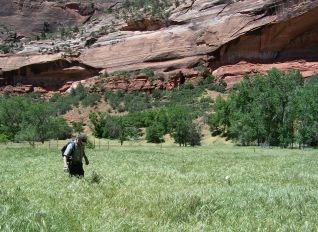
From Kolob Canyons to Zion Canyon, grasses are found in most park habitats, showcasing the dazzling diversity of life you might expect in a national park with 1,000 different species of vascular plants. Being wind pollinated, these not so showy flowers are well adapted to Zion’s breezy desert environment. They provide important forage for a diversity of wildlife that includes white-tailed antelope squirrels, mule deer and desert bighorn sheep. Grasses also help hold sandy soils in place, cutting down on erosion. Many desert grasses in Zion are especially adapted for desert temperatures and are able to close the pores, or stomata, in their leaves during the hottest time of day, thereby reducing water loss. Although Zion’s diverse habitats boast around 120 different species of grasses, these are not conspicuous plants. With their subtle beauty they do not command us to look, as a sunflower might. But when we stop to pause and take a closer look, we find not only a diversity of grass species, but of textures and patterns; grasses are beauty in motion with seed heads waving to us as we pass by. |
Last updated: July 9, 2017
